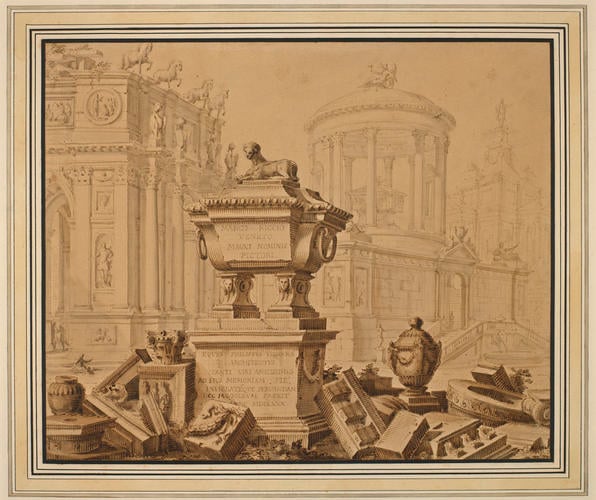An architectural caprice with a monument to Marco Ricci 1730
Pen and ink with brown and grey washes, on paper washed buff | 33.0 x 40.1 cm (sheet of paper) | RCIN 905906
-
A drawing of an imaginary tomb amidst relics of antique architecture; with classical buildings, including a rotunda, in the background. Inscribed on the monument: marco riccio / Veneto / magni nominis / pictori / eques philippus yuvarra / architectus / tanti viri amicissimus / ad eius memoriam / pie’ / inviolateque servandum / hoc mausoleum erexit / anno mdccxxx.
This drawing was evidently made on Ricci’s death in 1730. It is one of a wave of imaginary tomb designs produced in Italy in the early eighteenth century, such as the extravagant allegorical paintings commissioned by the impresario Owen Swiny (1676–1754) from various Bolognese and Venetian painters, including Marco Ricci himself, during the 1720s. A few years later Juvarra made a long series of drawings of fictive tombs to great men, including both Marco and his uncle Sebastiano Ricci (Museo Civico, Turin); but those are in the form of wall tombs, which could in principle have been built. The present drawing is by contrast an architectural fantasy, a capriccio, meticulously executed as a work of art in its own right.
In ambition and level of execution, the drawing is close to two groups of capricci by Juvarra executed around the same time. The first group, at Chatsworth, includes a frontispiece dated 1730, with a dedication to Lord Burlington, which is very similar in concept to the present sheet, with a triumphal arch to the left and circular temple to the right; Wittkower suggested that Juvarra might have sent the drawings to Burlington in thanks for a gift of Palladio’s Fabbriche Antiche that he had published in 1730. The second group is an album in Dresden of 41 architectural fantasies sent by Juvarra in 1732 to Augustus of Saxony; among these (folio 12) is a funerary monument dated 1730. The execution of the Dresden drawings, with pale washes in the background and short vertical strokes to model the foreground elements, is exactly that of the present drawing.
The circumstances of execution of the present drawing are unknown. It may have been intended to be engraved as a frontispiece to a collection of prints by Marco but no such engraving exists. The drawing was mounted by Joseph Smith (cf. RCIN 901984) in his album of drawings of stage designs by Ricci – but simply halfway through the album rather than as a frontispiece, as might have been expected.
Born in Sicily, the son of a goldsmith, Filippo Juvarra first practised as an engraver and then travelled to Rome in his mid-twenties to study architecture under Carlo Fontana. Where and when Juvarra and Marco Ricci became friends is uncertain, but there are numerous links between the two throughout their careers, and Ricci’s many stage designs are indebted to those of Juvarra.
Text adapted from Portrait of the Artist, London, 2016 -
Creator(s)
-
Medium and techniques
Pen and ink with brown and grey washes, on paper washed buff
Measurements
33.0 x 40.1 cm (sheet of paper)
Object type(s)









